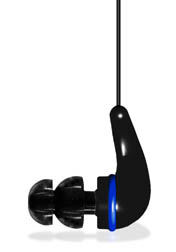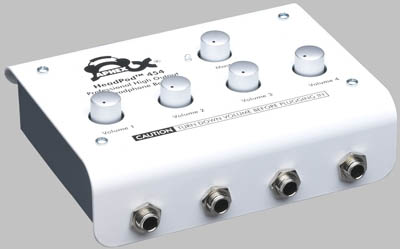Like wedge-based monitoring, each in-ear mix is very personal, but unlike with wedges, the only way to hear something is if it’s sent to that mix.
Stereo generally works better than mono. By leaving the listener’s inputs centered and panning other vocals or instruments, it’s easier to hear all the elements of the mix at a lower volume and this is crucial to hearing conservation over time. This is easily demonstrated by listening to a track in mono and then in stereo.
One drawback to wireless IEM is that due to the stereo multiplexed signal’s reduced separation, sources don’t pan as widely as with a hard-wired mix, so an input that would normally be panned hard at “5 o’clock” or “7 o’clock” now sounds like “9 or 3.”
A bigger drawback is the higher noise floor. If you don’t need to move around much, your IEMs will sound better with a hard-wired mix, but many musicians don’t want to give up the freedom of wireless.
I recommend an Aphex HeadPod 454 headphone amplifier for hard-wired mixes. It has a master volume and separate volume controls for up to four sets of headphones, allowing other musicians or technicians nearby to easily hear the same mix.
It has dual balanced quarter-inch line-level inputs, so you likely need a couple of XLR-female to TRS-male adaptors, and perhaps mini-TRS adaptors for each output. Its improved sound quality reduces hearing fatigue.
Even if all the inputs in a mix are panned center, a reverb return will always sound better in stereo.
Singers benefit from reverb in their mix and especially if each one can have their own dedicated reverb that can be tweaked to suit their taste, and not have another singer’s voice mixed into it.
Often, additional effects sends require additional mix outputs, so the tendency is to put background singers on mono mixes or even have them share a mix.
In modern digital desks, a dedicated reverb can be sent from a channel’s direct out or insert point, saving a mix bus that can then be used as the second send to that singer’s mix, to provide it in stereo.
Some musicians get confused by panned inputs, especially if they are “popping one ear out” occasionally or all the time. Listening with only one ear creates higher listening levels, which over time contributes to hearing loss.
Again, you can prove this to yourself, or others, by simply comparing the two methods. Most musicians who don’t get a good soundcheck before a performance are unsatisfied with their in-ear mix and often compensate by taking one ear out. Don’t give a musician who “pops one out” a mix with panned inputs until they begin consistently leaving them in.
One solution is clear. If you don’t have a monitor operator or time to make sure each musician has a good balance in their mix, the only other option is for each musician on in-ear monitors to have a small personal mixer to adjust their mix themselves.
If you don’t have a dedicated system like an Aviom A-16, Roland M-48 or Digidesign PQ, there are less expensive solutions.

For drummers or keyboard players, this can be a small analog mixer with line level feeds from the main console, supplemented with direct or mic inputs for their own instruments, perhaps an input for an iPod, click-track or a metronome, plus maybe a talk-back mic from the sound person or music director.
Another common problem is musicians trying to use inexpensive, low-quality iPod ear phones or other generic ear buds. They provide poor isolation from ambient sound and their inferior frequency response and distortion makes it harder to hear and contributes to hearing fatigue.
Better generic ear-buds can make a big difference, and quality products include Future Sonics Atrio, Westone UM-2, Monster Turbine and Shure SE530, depending on tonal preferences. Demo a pair and use them to listen to music you’re familiar with to see if you like them.
If you can only afford a cheap pair of buds, you may be better off getting a nice pair of closed, over-the-ear headphones, but the ears you save will definitely be yours.
Mark Frink is a professional monitor engineer and long-time writer and editor in professional audio.
















